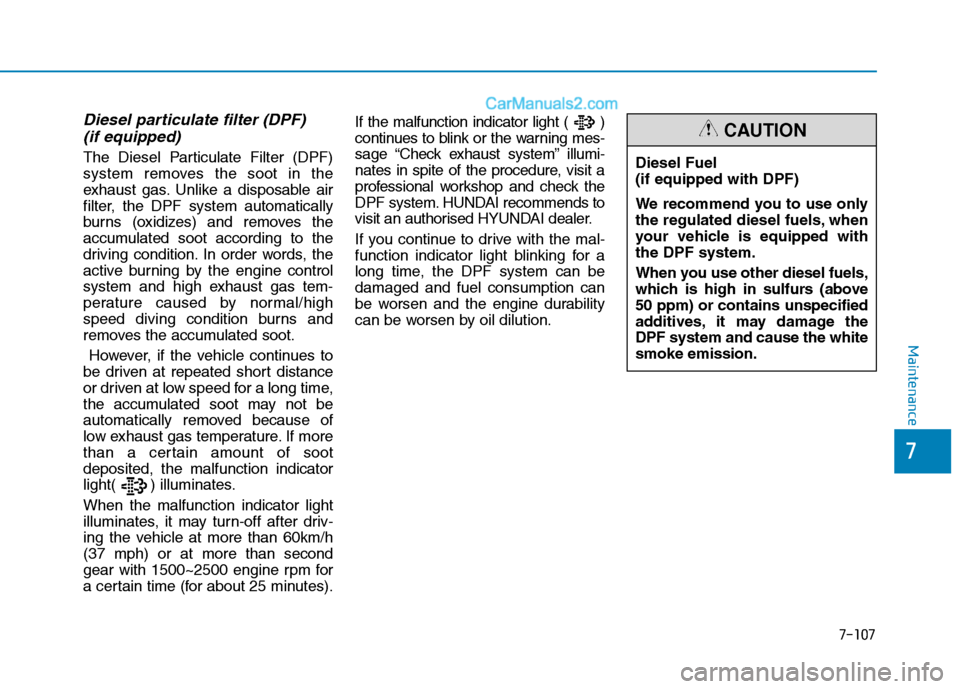Page 567 of 637

7-51
7
Maintenance
Battery capacity label
❈The actual battery label in the vehicle
may differ from the illustration.
1. CMF60L-BCI : The HYUNDAI
model name of battery
2. 12V : The nominal voltage
3. 60Ah(20HR) : The nominal capacity
(in Ampere hours)
4. 92RC : The nominal reserve capac-
ity (in min.)
5. 550CCA : The cold-test current in
amperes by SAE
6. 440A : The cold-test current in
amperes by EN
Battery recharging
Your vehicle has a maintenance-free,
calcium-based battery.
If the battery becomes discharged
in a short time (because, for exam-
ple, the headlamps or interior lights
were left on whilst the vehicle was
not in use), recharge it by slow
charging (trickle) for 10 hours.
If the battery gradually discharges
because of high electrical load
whilst the vehicle is being used,
recharge it at 20-30A for two hours.
OLMB073072 ■Example
When recharging the battery,
observe the following precau-
tions:
The battery must be removed
from the vehicle and placed in
an area with good ventilation.
Do not allow cigarettes,
sparks, or flames near the bat-
tery.
Watch the battery during
charging, and stop or reduce
the charging rate if the battery
cells begin gassing (boiling)
violently or if the temperature
of the electrolyte of any cell
exceeds 49°C (120°F).
Wear eye protection when
checking the battery during
charging.
WARNING
Page 623 of 637

7-107
7
Maintenance
Diesel particulate filter (DPF)
(if equipped)
The Diesel Particulate Filter (DPF)
system removes the soot in the
exhaust gas. Unlike a disposable air
filter, the DPF system automatically
burns (oxidizes) and removes the
accumulated soot according to the
driving condition. In order words, the
active burning by the engine control
system and high exhaust gas tem-
perature caused by normal/high
speed diving condition burns and
removes the accumulated soot.
However, if the vehicle continues to
be driven at repeated short distance
or driven at low speed for a long time,
the accumulated soot may not be
automatically removed because of
low exhaust gas temperature. If more
than a certain amount of soot
deposited, the malfunction indicator
light( ) illuminates.
When the malfunction indicator light
illuminates, it may turn-off after driv-
ing the vehicle at more than 60km/h
(37 mph) or at more than second
gear with 1500~2500 engine rpm for
a certain time (for about 25 minutes).If the malfunction indicator light ( )
continues to blink or the warning mes-
sage “Check exhaust system” illumi-
nates in spite of the procedure, visit a
professional workshop and check the
DPF system. HUNDAI recommends to
visit an authorised HYUNDAI dealer.
If you continue to drive with the mal-
function indicator light blinking for a
long time, the DPF system can be
damaged and fuel consumption can
be worsen and the engine durability
can be worsen by oil dilution.Diesel Fuel
(if equipped with DPF)
We recommend you to use only
the regulated diesel fuels, when
your vehicle is equipped with
the DPF system.
When you use other diesel fuels,
which is high in sulfurs (above
50 ppm) or contains unspecified
additives, it may damage the
DPF system and cause the white
smoke emission.
CAUTION
Page 633 of 637

8-9
8
Specifications & Consumer information
Recommended SAE viscosity
number
Engine oil viscosity (thickness) has
an effect on fuel economy and cold
weather operating (engine start and
engine oil flowability). Lower viscosi-
ty engine oils can provide better fuel
economy and cold weather perform-
ance, however, higher viscosity
engine oils are required for satisfac-
tory lubrication in hot weather. Using
oils of any viscosity other than those
recommended could result in engine
damage.a
Always be sure to clean the area
around any filler plug, drain
plug, or dipstick before check-
ing or draining any lubricant.
This is especially important in
dusty or sandy areas and when
the vehicle is used on unpaved
roads. Cleaning the plug and
dipstick areas will prevent dirt
and grit from entering the
engine and other mechanisms
that could be damaged.
CAUTION
When choosing an oil, consider the range of temperature your vehicle will be
operated in before the next oil change.
Proceed to select the recommended oil viscosity from the chart.
*1: For better fuel economy, it is recommended to use the engine oil of a viscosity grade
SAE 5W-30. However, if the engine oil is not available in your country, select the prop-
er engine oil using the engine oil viscosity chart.
*
2: For better fuel economy, it is recommended to use the engine oil of a viscosity grade
SAE 5W-20.
Temperature Range for SAE Viscosity Numbers
Temperature°C
(°F)-30 -20 -10 0 10 20 30 40 50
-10 0 20 40 60 80 100 120
2.0 GDI
20W-50
10W-30
15W-40
5W-20*2, 5W-30
20W-50
15W-40
10W-30
5W-30*1, 5W-40
1.6 T-GDI
■Petrol Engine Oil
■Diesel Engine Oil
Temperature Range for SAE Viscosity Numbers
Temperature°C
(°F)-30 -20 -10 0 10 20 30 40
-10 0 20 40 60 80 100
5W-30/40
10W-30/40
0W-30/40
2.0 TCI